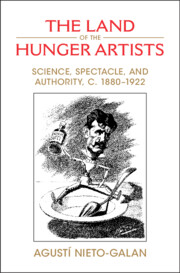
- Publisher:
- Cambridge University Press
- Online publication date:
- November 2023
- Print publication year:
- 2023
- Online ISBN:
- 9781009379540

From the 1880s to the 1920s, hunger artists - professional fasters - lived on the fringes of public spectacle and academic experiment. Agustí Nieto-Galan presents the history of this phenomenon as popular urban spectacle and subject of scientific study, showing how hunger artists acted as mediators between the human and the social body. Doctors, journalists, impresarios , artists, and others used them to reinforce their different philosophical views, scientific schools, political ideologies, cultural values, and professional interests. The hunger artists generated heated debates on objectivity and medical pluralism, and fierce struggles over authority, recognition, and prestige. Set on the fringes of the freak show culture of the nineteenth century and the scientific study of physiology laboratories, Nieto-Galan explores the story of the public exhibition of hunger, emaciated bodies, and their enormous impact on the public sphere of their time.
Long-listed, 2024 John Pickstone Prize, The British Society for the History of Science
‘Agustí Nieto-Galan’s book offers the first in-depth and scholarly account of the hunger artists of Italy after unification. Drawing on the rich body of texts, images, and goods that marked the spectacular fasts of these individuals on their global trajectories, he skillfully balances the perspectives of rapt publics, doubting doctors, enthusiastic impresarios, and an expanding media culture. Diverse groups of commentators contended over the veracity or fraudulence of the capabilities of their extraordinary bodies, as well as over what profits could be made out of them. In a period that gave rise to most of our modern categories of food requirements and eating disorders, these men came to exemplify both the limits and the potential of nutrition science, both inside and outside the laboratory. A fascinating book that stands at the intersection of many areas of historical interest.’
Emma Spary - University of Cambridge
‘In this engaging study of hunger artists in late nineteenth-century Europe, Nieto-Galan pushes the history of hunger in new directions. Were hunger artists freaks of nature, charlatans looking for easy gain, fruitful subjects for medical research, or savvy entertainers? By examining contemporary debates, Nieto-Galan shows how these artists shaped scientific and popular understandings of hunger while simultaneously updating the performative aspects of hunger for the modern world.’
Corinna Treitel - Professor and Chair, Department of History, Washington University in St Louis
 Loading metrics...
Loading metrics...
* Views captured on Cambridge Core between #date#. This data will be updated every 24 hours.
Usage data cannot currently be displayed.